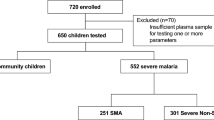Summary
Hereditary ovalocytosis in Papua New Guinea is restricted to areas of endemic malaria and may confer increased resistance to the disease. The incidence of malaria was investigated in 1616 Melanesians of known red cell morphology and severity of infection determined in a smaller subsample. Ovalocytics tended to be more resistant to severe malarial infections than normocytics. The ratio of parasitaemia in 112 ovalocytics compared with 741 normocytic children was 1.05 for P. falciparum; 0.90 for P.vivax; 0.54 for P. malariae, and 0.91 for infection with any species. The difficulties in conclusively demonstrating any selective advantage of the condition are discussed.
Similar content being viewed by others
References
Amato, D., Andrews, S.: Elliptocytosis in Papua New Guinea. Proc. Int. Soc. Haemat., Asian-Pacific Div. (Jakarta) 124 (1975)
Baer, A., Lie-Injo, L. E., Welch, Q. B., Lewis, A. N.: Genetic factors and malaria in the Temuan. Am. J. Hum. Genet. 28, 179–188 (1976)
Booth, P. B.: The occurrence of weak IT red cell antigen among Melanesians. Vox Sang. 22, 64–72 (1972)
Booth, P. B., Serjeantson, S., Woodfield, D. G., Amato, D.: Selective depression of blood group antigens associated with hereditary ovalocytosis among Melanesians. Vox Sang. 32, 99–110 (1977)
Field, J. W.: Blood examination and prognosis in acute falciparum malaria. Trans. R. Soc. Trop. Med. Hyg. 43, 33–48 (1949)
Lie-Injo, L. E.: Genetic relationships of several aboriginal groups in Southeast Asia. In: Origin of the Australians (R. L. Kirk, A. G. Thorne, eds.), pp. 277–306. Canberra: Australian Institute of Aboriginal Studies 1976
Lie-Injo, L. E., Fix, A., Bolton, J. M., Gilman, R. H.: Haemoglobin E-hereditary elliptocytosis in Malayan aborigines. Acta Haematol. (Basel) 47, 210–216 (1972)
Livingstone, F. B.: Malaria and human polymorphisms. Annu. Rev. Genet. 5, 33–64 (1971)
Luzzatto, L., Nwachuku-Jarrett, E. S., Reddy, S.: Increased sickling of parasitised erythrocytes as mechanism of resistance against malaria in the sickle-cell trait. Lancet 1970 I, 319–322
Miller, L. H., Mason, S. J., Dvorak, J. A., McGinniss, M. H., Rothman, J. K.: Erythrocy receptors of (Plasmodium knowlesi) malaria: Duffy blood group determinants. Science 189, 561–562 (1975)
Pasvol, G., Weatherall, D. J., Wilson, R. J. M., Smith, D. H., Gilles, H. M.: Fetal haemoglobin and malaria. Lancet 1976 I, 1269–1272
Simmons, R. T., Booth, P. B.: A compendium of Melanesian genetic data II, pp. 8–9. Melbourne: Commonwealth Serum Laboratories 1971
Wurm, S. A.: The emerging linguistic picture of the southwestern Pacific—and linguistic prehistory. In: Language in anthropology, vol. 3: Approaches to language. The Hague: Mouton (1977, in press)
Author information
Authors and Affiliations
Rights and permissions
About this article
Cite this article
Serjeantson, S., Bryson, K., Amato, D. et al. Malaria and hereditary ovalocytosis. Hum Genet 37, 161–167 (1977). https://doi.org/10.1007/BF00393579
Received:
Issue Date:
DOI: https://doi.org/10.1007/BF00393579




